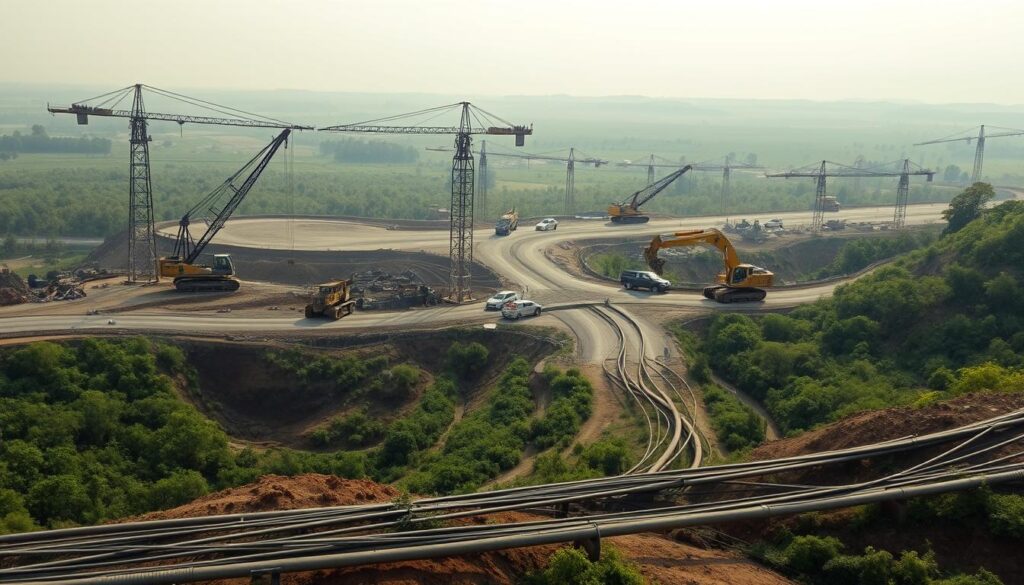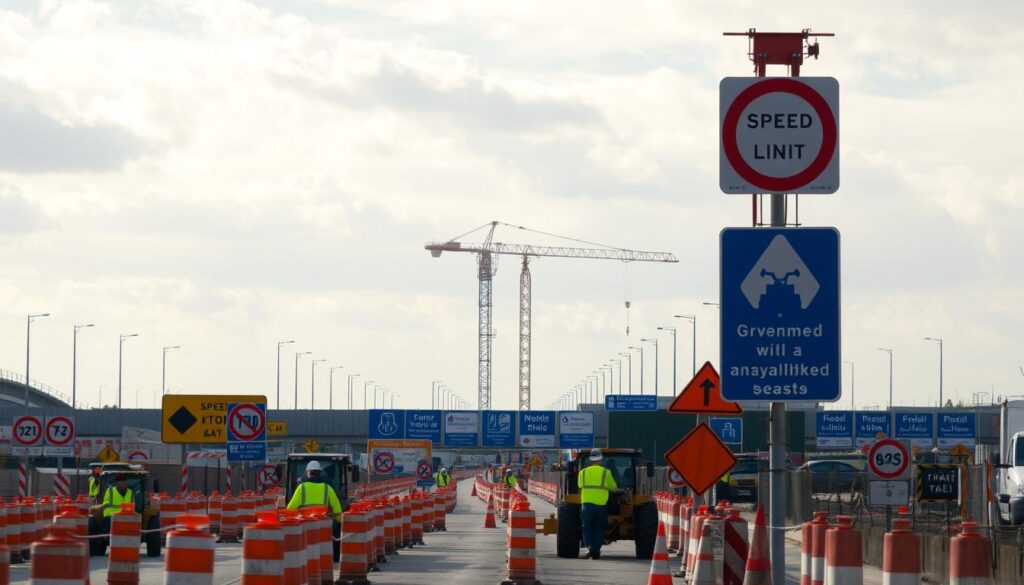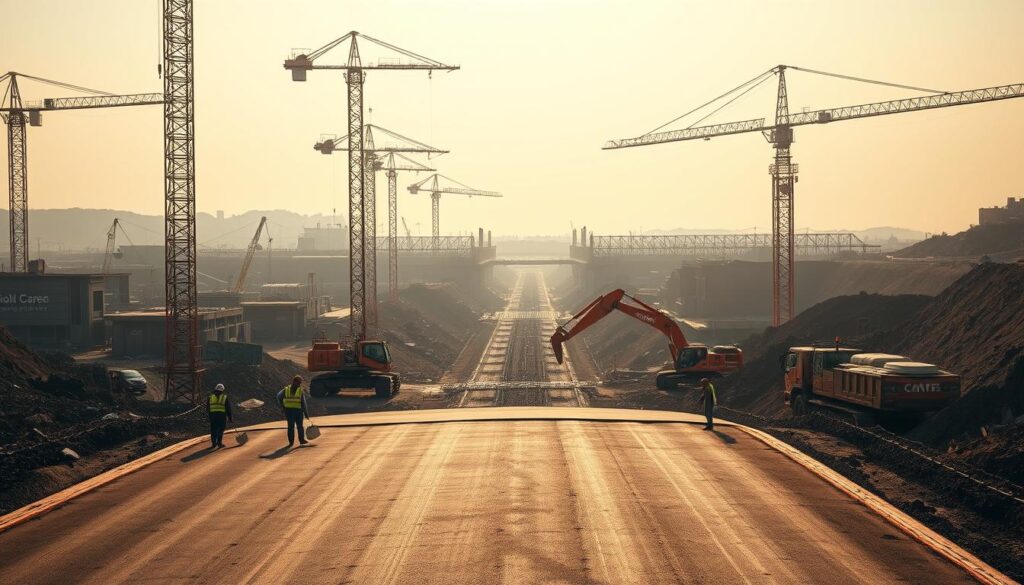The total length of paved roads across the globe stretches over 60 million kilometers, a staggering figure that underscores the importance of road construction engineering in modern society.
This vast network facilitates the movement of goods and people, playing a critical role in economic development and social connectivity. Effective infrastructure development is crucial for maintaining and improving this network, ensuring that roads are safe, durable, and efficient.
Key Takeaways
- The global network of paved roads is over 60 million kilometers long.
- Road construction engineering is vital for economic development and social connectivity.
- Infrastructure development is key to maintaining and improving road networks.
- Effective road design ensures safety, durability, and efficiency.
- Civil engineering plays a crucial role in road construction and maintenance.
Understanding Road Construction Engineering
Effective road construction engineering is crucial for developing infrastructure that supports economic growth and community connectivity. It encompasses a wide range of projects, from building new roadways to expanding existing ones, involving planning, design, and construction.
What is Road Construction Engineering?
Road construction engineering is a specialized field within transportation engineering that focuses on the planning, design, and construction of roads. It requires a deep understanding of roadway design principles, materials science, and construction methodologies to ensure that roads are safe, durable, and environmentally sustainable.
The process involves several stages, including feasibility studies, detailed design, and construction management. Engineers must consider factors such as traffic volume, environmental impact, and community needs when designing roadways.
Importance in Infrastructure Development
Road construction engineering plays a vital role in infrastructure development, contributing to economic growth by facilitating the movement of goods and people. Well-designed roads can reduce travel times, improve safety, and enhance connectivity between communities.
“The quality of a nation’s infrastructure is a critical factor in its economic competitiveness.”
Moreover, road construction engineering is essential for ensuring that infrastructure development aligns with sustainability goals. This includes using sustainable materials, minimizing environmental impact, and designing roads that can withstand the effects of climate change.
| Aspect | Importance | Benefits |
|---|---|---|
| Planning | Ensures alignment with community needs and environmental considerations | Better project outcomes, reduced costs |
| Design | Critical for safety and durability | Reduced accidents, longer road lifespan |
| Construction | Execution of the planned design | Quality infrastructure, minimal disruptions |
For more information on managing civil engineering projects, including road construction, visit World Civil Society.
Key Principles of Road Design
Roadway design is a multifaceted discipline that requires careful planning, precise execution, and a deep understanding of safety standards. Effective road design balances various factors, including traffic volume, terrain, and environmental impact, to create infrastructure that is both functional and sustainable.

Sustainability in Road Engineering
Sustainability has become a cornerstone in modern road engineering. This involves using materials and techniques that minimize environmental impact while ensuring the durability and longevity of the road. Green infrastructure, such as permeable pavements and recycled materials, is increasingly being incorporated into road design to reduce the ecological footprint.
The use of sustainable materials not only benefits the environment but also can lead to cost savings over the life cycle of the road. For instance, materials that are more resistant to weathering can reduce maintenance costs and extend the road’s lifespan.
Safety Standards and Regulations
Safety is a paramount concern in road design, with numerous regulations and standards in place to ensure that roads are constructed to protect users. These standards cover various aspects, from the geometric design of the road to the materials used in its construction.
Strict adherence to safety standards is crucial for minimizing the risk of accidents and ensuring that roads can accommodate different types of users, including vehicles, pedestrians, and cyclists. Regulations also play a key role in construction management, guiding the practices and processes that contractors must follow.
By integrating sustainability and safety into road design, engineers can create infrastructure that not only supports the needs of the community but also protects the environment and enhances user safety.
Types of Road Construction Materials
The choice of materials in road construction significantly impacts the durability and sustainability of the infrastructure. Road construction materials can be broadly categorized into two main types based on the pavement design: rigid and flexible pavements.
Asphalt vs. Concrete: Which is Best?
Asphalt and concrete are the two primary materials used in road construction. Asphalt, a flexible pavement, is known for its ability to withstand heavy traffic and harsh weather conditions. On the other hand, concrete, a rigid pavement, offers durability and low maintenance costs over its lifespan.
The decision between asphalt and concrete depends on various factors, including the expected traffic volume, climate, and budget. For instance, asphalt is often preferred for roads with heavy traffic due to its flexibility and ability to be recycled. Conversely, concrete is chosen for its long-term durability and resistance to deformation.
Innovations in Sustainable Materials
In recent years, there has been a significant shift towards the use of sustainable materials in road construction. These materials not only reduce the environmental impact but also offer improved performance and longevity. Some examples include recycled asphalt pavement, warm-mix asphalt, and permeable pavers.
For a more detailed comparison, let’s examine the characteristics of different road construction materials in the following table:
| Material | Durability | Maintenance Cost | Environmental Impact |
|---|---|---|---|
| Asphalt | High | Medium | Medium |
| Concrete | Very High | Low | High |
| Recycled Asphalt | High | Low | Low |
| Warm-Mix Asphalt | High | Medium | Low |
As the industry continues to evolve, the adoption of sustainable building materials is expected to grow, driven by environmental concerns and the need for cost-effective solutions.
The Road Construction Process
The road construction process is a complex series of steps that require meticulous planning and execution. It involves several phases, from initial planning and feasibility studies to the actual construction and final inspection.

Project Planning and Feasibility Studies
Effective project planning is crucial for the success of any road construction project. This phase involves conducting feasibility studies to determine the practicality of the proposed project. Factors such as environmental impact, budget, and potential road usage are assessed during this stage.
Key activities during project planning include:
- Conducting environmental impact assessments
- Engaging with local communities and stakeholders
- Defining project scope and objectives
- Establishing budget and resource allocation
Timeline and Milestone Expectations
Creating a realistic timeline is essential for managing expectations and ensuring that the project stays on track. This involves setting clear milestones and deadlines for each phase of the construction process.
| Project Phase | Typical Duration | Key Milestones |
|---|---|---|
| Planning and Design | 3-6 months | Completion of design, environmental approvals |
| Land Acquisition | 6-12 months | Acquisition of necessary land, resolution of disputes |
| Construction | 12-24 months | Completion of road base, paving, installation of infrastructure |
By understanding the road construction process and its various phases, stakeholders can better manage their expectations and contribute to the project’s overall success.
Role of Technology in Road Construction
Technology plays a crucial role in modern road construction, from planning and design to execution and maintenance. The industry has witnessed significant advancements in recent years, leading to improved efficiency, reduced costs, and enhanced safety.
Data Analysis and Project Management Software
Data analysis and project management software are revolutionizing the way road construction projects are managed. These tools enable project managers to track progress, identify potential issues, and make data-driven decisions. For instance, AI technologies are being used to analyze data from various sources, including sensors and drones, to optimize project outcomes.
The benefits of using data analysis and project management software include:
- Improved project tracking: Real-time monitoring of project progress.
- Enhanced collaboration: Better communication among team members and stakeholders.
- Data-driven decision-making: Informed decisions based on accurate data.
Use of Drones and Mapping Technology
Drones are being increasingly used in road construction for surveying, monitoring, and inspection. They provide high-resolution aerial imagery and topographic data, which can be used to create detailed 3D models of the construction site. For example, AutoCAD Civil 3D is a software that can be used in conjunction with drone data to design and plan road construction projects.
The advantages of using drones and mapping technology include:
- Improved accuracy: High-resolution data for accurate planning and design.
- Increased safety: Reduced need for physical site visits, minimizing the risk of accidents.
- Enhanced monitoring: Real-time monitoring of project progress and site conditions.
Environmental Considerations in Road Construction
Assessing and mitigating the environmental impact of road construction is crucial for preserving natural habitats and reducing pollution. Road construction projects can significantly affect the environment, leading to habitat disruption, water pollution, and increased air pollution.

Assessing Environmental Impact
Conducting thorough environmental impact assessments is essential before commencing any road construction project. This involves evaluating the potential effects on local ecosystems, wildlife habitats, and water sources. For instance, a study on the impact of road construction in Africa highlighted the need for careful planning to minimize environmental damage.
Environmental impact assessments help identify potential risks and opportunities for implementing sustainable practices. This proactive approach enables project managers to develop strategies that mitigate adverse effects on the environment.
Strategies for Minimizing Ecological Disruption
Several strategies can be employed to minimize ecological disruption during road construction. These include:
- Implementing sustainable drainage systems to reduce water pollution.
- Using recycled materials where possible to minimize waste.
- Creating wildlife corridors to help maintain biodiversity.
- Employing noise reduction techniques to minimize disturbance to local wildlife.
By adopting these strategies, road construction projects can significantly reduce their ecological footprint. It’s also important to engage with local communities and stakeholders to ensure that their concerns are addressed and that the project benefits the local environment and economy.
Key Challenges in Road Construction Projects
Road construction projects are fraught with challenges that can significantly impact their success. Effective construction management is crucial in navigating these challenges to ensure projects are completed on time and within budget.
Managing Budget Constraints
One of the primary challenges in road construction is managing budget constraints. Projects often face unforeseen expenses due to changes in material costs, labor rates, or unexpected site conditions. To mitigate these risks, project managers must engage in thorough planning and continuous monitoring of expenses. Utilizing construction management software can help track costs and identify areas for potential savings.
Effective budgeting also involves anticipating potential cost overruns and having contingency plans in place. This includes negotiating contracts that allow for flexibility in response to changing conditions and maintaining open communication with stakeholders about budgetary constraints and adjustments.
Dealing with Weather Conditions
Weather conditions pose another significant challenge to road construction projects. Inclement weather, such as heavy rain, snow, or extreme temperatures, can halt construction activities, leading to delays and increased costs. Project managers must develop strategies to mitigate the impact of adverse weather, including scheduling critical tasks during favorable weather periods and implementing protective measures to safeguard work in progress.
Moreover, incorporating climate resilience into road design can help minimize the long-term impacts of weather conditions on the infrastructure. This involves using materials and design techniques that can withstand local climate conditions, thereby reducing the need for costly repairs or reconstruction in the future.
The Importance of Maintenance and Upkeep
The longevity of roads depends significantly on regular maintenance and upkeep. Without proper care, roads can deteriorate quickly, leading to safety hazards and increased maintenance costs over time.
Why Regular Inspections Matter
Regular inspections are the backbone of effective road maintenance. They help identify potential issues before they become major problems. By conducting routine inspections, maintenance teams can:
- Detect early signs of wear and tear
- Assess the condition of road surfaces and infrastructure
- Prioritize repairs based on urgency and importance
Regular inspections not only improve safety but also help in budgeting and planning for future maintenance activities. They are a proactive approach to managing road infrastructure.
Techniques for Road Repairs and Upgrades
Various techniques are employed for road repairs and upgrades, each suited to different types of damage or deterioration. Some common methods include:
| Technique | Description | Application |
|---|---|---|
| Resurfacing | Laying a new layer of asphalt over the existing surface | Used for roads with significant surface wear |
| Patching | Repairing specific areas of damage | Ideal for localized damage or potholes |
| Reconstruction | Completely rebuilding the road | Necessary for roads with extensive structural damage |
Choosing the right technique depends on the extent of the damage, traffic volume, and budget constraints. Effective maintenance ensures that roads remain safe and durable.

By understanding the importance of maintenance and upkeep, and by employing the right techniques, we can extend the lifespan of our roads and ensure they continue to serve their purpose effectively.
Road Construction Engineering Careers
The field of road construction engineering is crucial for modern infrastructure, presenting numerous career paths for aspiring engineers. As the demand for well-designed and durable roads continues to grow, so does the need for skilled professionals in this field.
Essential Skills for Aspiring Engineers
A career in road construction engineering requires a specific set of skills. These include:
- Technical Skills: Proficiency in civil engineering software and technologies.
- Project Management: Ability to manage projects from conception to completion.
- Problem-Solving: Strong analytical skills to address construction challenges.
- Communication: Effective communication with teams, stakeholders, and clients.
Developing these skills can significantly enhance an engineer’s career prospects in road construction engineering.
Educational Pathways and Certifications
To succeed in road construction engineering, one must pursue the right educational pathways and certifications. Here’s a breakdown:
| Degree/Certification | Description | Benefits |
|---|---|---|
| Bachelor’s in Civil Engineering | Fundamental education in civil engineering principles. | Foundation for understanding road construction engineering. |
| Master’s in Transportation Engineering | Advanced study focusing on transportation systems. | Specialized knowledge in road and transportation engineering. |
| Professional Engineer (PE) License | Certification to practice as a professional engineer. | Signifies expertise and commitment to the profession. |
Aspiring road construction engineers can benefit from these educational pathways and certifications to advance their careers.
Local vs. National Road Projects
Road projects, whether local or national, require tailored approaches to meet specific needs and regulations. The scale and complexity of these projects vary significantly, influencing how they are funded, managed, and executed.
Differences in Approaches and Regulations
Local road projects typically focus on community needs, such as improving traffic flow or enhancing safety within a specific area. These projects are often managed by local authorities who are more attuned to the community’s requirements. In contrast, national road projects are larger in scale, aiming to connect cities or regions across the country. They are subject to federal regulations and require coordination among multiple stakeholders.
Regulatory differences are significant between local and national projects. National projects must comply with federal highway administration guidelines, which include stringent safety and environmental standards. Local projects, while still adhering to state and local regulations, have more flexibility in their design and implementation.

How Projects Are Funded and Managed
Funding for road projects can come from various sources, depending on whether the project is local or national. National projects are often funded through federal highway funds, while local projects rely on local budgets, grants, or public-private partnerships.
| Project Aspect | Local Road Projects | National Road Projects |
|---|---|---|
| Funding Sources | Local budgets, grants, public-private partnerships | Federal highway funds, government allocations |
| Regulatory Oversight | Local and state regulations | Federal regulations, environmental impact assessments |
| Management Approach | Community-focused, managed by local authorities | Large-scale, managed by federal and state agencies |
The management of these projects also differs. National projects involve complex project management structures, including multiple stakeholders and contractors. Local projects, being smaller, typically have more straightforward management processes.
In conclusion, understanding the differences between local and national road projects is essential for effective highway engineering and project management. By recognizing these differences, stakeholders can better plan, fund, and execute road projects that meet their specific needs and comply with relevant regulations.
Case Studies: Successful Road Construction Projects
Examining case studies of successful road construction projects reveals the complexities and triumphs in modern infrastructure development. These projects, whether in urban or rural settings, demonstrate the impact of effective planning, innovative engineering, and community engagement.
Infrastructure Development in Urban Areas
Urban road construction projects face unique challenges, including high population density and existing infrastructure. A notable example is the redevelopment of the Highway 101 in San Francisco, California. This project involved reconstructing a major highway, improving traffic flow, and enhancing pedestrian and cyclist safety.
“The reconstruction of Highway 101 was a landmark project that not only improved traffic conditions but also revitalized the surrounding urban landscape.” –
Such projects highlight the importance of integrating innovative road design with urban planning to create sustainable and efficient transportation systems.
Innovative Roadways in Rural Communities
Rural road construction projects often focus on improving connectivity and accessibility. An example is the development of smart roads in rural areas, incorporating technologies like solar-powered roadways and intelligent traffic management systems.
- Improved safety through intelligent traffic signals
- Enhanced durability with innovative materials
- Increased efficiency through real-time traffic monitoring
These innovations not only improve the quality of rural roads but also contribute to the economic development of these areas by enhancing connectivity and accessibility.
Future Trends in Road Construction Engineering
Emerging trends in road construction engineering, including the development of smart roads and connected vehicles, are set to revolutionize transportation. As the world becomes increasingly interconnected, the need for efficient, safe, and sustainable road networks is more pressing than ever.
Smart Roads and Connected Vehicles
The concept of smart roads involves integrating advanced technologies into road infrastructure to enhance safety, reduce congestion, and improve the overall driving experience. This includes the use of sensors, intelligent lighting, and real-time data analytics to monitor and manage traffic flow. Connected vehicles, which can communicate with each other and with the infrastructure, are a crucial component of this ecosystem, enabling features like real-time traffic updates and collision avoidance systems.

The development of smart roads is not just about technology; it’s also about creating a more sustainable and environmentally friendly transportation system. By optimizing traffic flow and reducing congestion, smart roads can help decrease emissions and improve air quality.
The Role of Autonomous Technology in Road Use
Autonomous technology is another significant trend shaping the future of road construction engineering. As vehicles become increasingly autonomous, roads will need to be designed with this technology in mind, incorporating features like dedicated lanes and advanced communication systems. This shift has the potential to greatly enhance safety on our roads, as autonomous vehicles can detect and respond to hazards more quickly and accurately than human drivers.
| Trend | Description | Potential Impact |
|---|---|---|
| Smart Roads | Integration of advanced technologies into road infrastructure | Enhanced safety, reduced congestion |
| Connected Vehicles | Vehicles that communicate with each other and infrastructure | Real-time traffic updates, collision avoidance |
| Autonomous Technology | Vehicles capable of autonomous operation | Improved safety, enhanced mobility |
As these trends continue to evolve, it’s clear that the future of road construction engineering will be shaped by a combination of technological innovation, sustainability, and a commitment to safety. By embracing these changes, we can create a transportation system that is more efficient, more sustainable, and more responsive to the needs of our communities.
The Impact of Road Construction on Communities
Road construction projects have a profound impact on communities, affecting both local economies and social dynamics. The effects of road construction are multifaceted, bringing about changes that can be both beneficial and challenging for the community.
Economic Benefits of Improved Roadways
The construction of roads can significantly boost local economies. Improved roadways can lead to increased business activity, as better transportation infrastructure makes it easier for goods and services to be transported. This, in turn, can lead to job creation and economic growth. Some of the key economic benefits include:
- Increased access to markets and resources
- Enhanced connectivity, facilitating the movement of goods and people
- Attraction of new businesses and investments due to improved infrastructure
Moreover, improved roads can also increase property values, as accessibility and connectivity are key factors that homebuyers and businesses consider when choosing a location.
Social Effects and Community Involvement
Road construction also has significant social effects on communities. While improved roads can enhance connectivity and access, they can also lead to displacement of residents, noise pollution, and other negative impacts. It’s crucial for community involvement in the planning process to mitigate these effects. Some strategies for effective community involvement include:
- Public consultations to gather feedback and concerns from the community
- Transparent communication about the project’s timeline, benefits, and potential impacts
- Incorporating community suggestions into the project design where feasible
By engaging with the community, project planners can better understand local needs and concerns, ultimately leading to more successful and sustainable road construction projects.
Government Regulations Affecting Road Construction
Understanding government regulations is crucial for the successful planning and implementation of road construction projects. These regulations not only ensure that projects are executed safely and efficiently but also that they comply with environmental and social standards.

Key Legislation to Know
Several key pieces of legislation govern road construction in the United States. The National Environmental Policy Act (NEPA) of 1969 is pivotal, as it requires federal agencies to consider the environmental impacts of their actions. Another significant legislation is the Highway Safety Act, which focuses on improving safety standards on highways.
Additionally, the Clean Water Act and the Endangered Species Act play crucial roles in regulating how road construction projects affect water resources and wildlife habitats. Compliance with these laws is not only mandatory but also essential for minimizing the ecological footprint of road construction.
Permitting Process and Compliance
The permitting process is a critical component of road construction, involving various government agencies at the federal, state, and local levels. Obtaining the necessary permits requires detailed project planning and documentation, including environmental impact assessments and safety plans.
To ensure compliance, project managers must work closely with regulatory bodies throughout the project lifecycle. This includes adhering to permit conditions, conducting regular inspections, and reporting any changes or issues that may arise during construction.
- Conduct thorough environmental impact assessments.
- Engage with local communities and stakeholders.
- Ensure all necessary permits are obtained before commencing work.
- Regularly inspect the construction site to maintain compliance with safety and environmental regulations.
By understanding and complying with government regulations, road construction projects can be completed on time, within budget, and with minimal environmental impact. This not only benefits the project’s bottom line but also contributes to the well-being of the communities they serve.
Enhancing Road Safety Through Engineering
Road safety is a critical concern that engineers address through designing safer roads and implementing smart traffic solutions. Effective road safety measures are crucial for reducing accidents and saving lives. Engineering plays a pivotal role in this endeavor, combining innovative design principles with cutting-edge technology.

Designing Roads for Driver Safety
Designing roads with safety in mind involves several key considerations. Engineers must assess the road’s geometry, surface quality, and surrounding environment to identify potential hazards. For instance, implementing clear signage and proper lighting can significantly reduce the risk of accidents, especially at night or in low-visibility conditions.
Moreover, the incorporation of traffic calming measures, such as speed bumps or roundabouts, can help to reduce vehicle speeds and improve overall safety. The layout of intersections and interchanges is also critical, as these areas are often prone to congestion and accidents. By optimizing these designs, engineers can minimize the risk of collisions and enhance the overall flow of traffic.
For more insights on the role of traffic engineers in improving road safety, visit Green Light Traffic Engineering.
Incorporating Smart Traffic Solutions
In addition to road design, the integration of smart traffic solutions is vital for enhancing road safety. These solutions leverage advanced technologies, such as real-time data analytics and IoT sensors, to monitor and manage traffic flow. For example, intelligent traffic signals can adjust their timing based on real-time traffic conditions, reducing congestion and minimizing the risk of accidents.
Furthermore, the use of surveillance cameras and emergency response systems enables quick detection and response to incidents, thereby reducing their impact. By harnessing the power of data and technology, engineers can create a safer and more efficient transportation network.
Conclusion: The Future of Road Construction Engineering
The future of road construction engineering is marked by a blend of innovation and a growing emphasis on responsibility, shaping the infrastructure of tomorrow.
Innovative Approaches
As technology advances, the road construction industry is adopting innovative approaches, such as using sustainable materials and integrating smart roads with connected vehicles. These developments not only enhance the durability and safety of roadways but also contribute to a more sustainable environment.
Responsibility in Action
Engineers and stakeholders must prioritize responsibility in their projects, ensuring that road construction minimizes ecological disruption and maximizes community benefits. By doing so, the industry can create infrastructure that supports economic growth and social well-being.
Aspiring engineers are encouraged to embrace these challenges, leveraging their skills and knowledge to drive the future of road construction engineering. By focusing on innovation and responsibility, the next generation of engineers can build a more sustainable and connected world.
